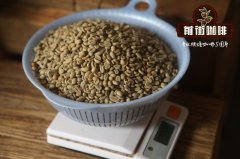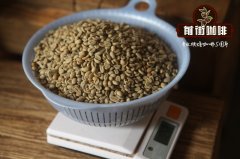What is the difference between Golden Honey treatment and General Honey treatment Pearl Paloma Manor Golden Honey Coffee

Honey processing is almost synonymous with Costa Rica!
The honey treatment was first developed to improve the centuries-old fermentation washing method; there are two kinds of washing method, one is the traditional washing method, which consumes a lot of water, and the other is to mechanically scrape off the pectin layer attached to the surface of coffee seeds. After scraping off, the beans with shells will be as clean as the beans after fermentation washing. After drying, the beans will appear pale yellow, which is not much different from the appearance of traditional washed beans, so it is also called "mechanically washed beans."
However, if slight adjustments are made in the step of scraping off the pectin layer, such as retaining part or all of the pectin layer, and then drying, it becomes a so-called honey treatment. These nutrient-rich pectin layers penetrate the beans through browning and fermentation in the sun, making the subsequent flavor more sweet. After many years of experiments, farmers found that the more browning helps to improve the sweetness, and the more pectin, the more browning potential, thus deriving white, yellow, red, black and other four honey treatment degrees.
But does the degree of honey treatment depend directly on pectin retention?
Not really, and golden honey treatment is a prime example. Golden honey-treated "golden yellow" refers to the golden color of shelled beans in sunlight, that is, the color of dried pectin that has not been browned or fermented.
In principle, golden honey treatment and black honey treatment are the same, completely retaining the pectin layer, but the biggest difference is that the exposure process of black honey treatment needs to pay great attention to temperature and drying speed, and strive to dry in a low temperature and dry environment, so that the nutrients in the pectin layer have no chance to brown and ferment, only to concentrate the nutrients in the original pectin layer and then seep back to the beans, so there is no flavor substance. On the contrary, golden honey treatment, because after browning and fermentation, so that the pectin layer can really penetrate into the raw beans. Therefore, the degree of honey treatment depends not so much on the amount of pectin retained, but rather on the browning and fermentation of the pectin layer.
The golden honey treatment we present this time is from Pearl Paloma Estate in Costa Rica. The owner, Don Carlos, is a new but fast-rising coffee grower who previously served from Costa Rica's famous Helbasu processing plant and then founded Paloma Manor himself. He is a very successful coffee grower!
Honey treatment is very sweet, and this "golden" honey treatment beans, flavor is extraordinary! Baked in a medium light, it tastes like eating a golden brie, crispy caramel and honey, sweet full marks! The hazelnut on the palate is smooth and rich in flavor. He didn't feel any sourness or bitterness at all. It was no exaggeration to say that he was the sweetheart of the coffee world!
Important Notice :
前街咖啡 FrontStreet Coffee has moved to new addredd:
FrontStreet Coffee Address: 315,Donghua East Road,GuangZhou
Tel:020 38364473
- Prev

Why is Bolivia called Coffee Paradise an introduction to the characteristics of coffee in La Paz, Bolivia
If you want to talk about the paradise of coffee beans, it is Bolivia. This producing area can be regarded as one of the most recommended boutique coffee producing areas. Most of the coffee beans in this producing area are a little sweet and very pleasing, but the number of coffee beans is very small. This country, located in Central and South America, is one of the five most diverse countries in the world, surrounded by five countries.
- Next

Introduction of coffee flavor of honeybee cooperative in Neri, Kenya introduction of Kenyan AA top grade coffee
Traditionally, Kenyan coffee has a distinct black plum tone, and many people will be deterred by friends who are afraid of sour. But the coffee beans produced by the Honey Cooperative in Kenya are very different, with the same flavor as his name, with obvious honey sweetness in addition to the slight acidity of berries. The entrance will certainly subvert your traditional impression of Kenya, oh honey cooperative (T
Related
- Detailed explanation of Jadeite planting Land in Panamanian Jadeite Manor introduction to the grading system of Jadeite competitive bidding, Red bid, Green bid and Rose Summer
- Story of Coffee planting in Brenka region of Costa Rica Stonehenge Manor anaerobic heavy honey treatment of flavor mouth
- What's on the barrel of Blue Mountain Coffee beans?
- Can American coffee also pull flowers? How to use hot American style to pull out a good-looking pattern?
- Can you make a cold extract with coffee beans? What is the right proportion for cold-extracted coffee formula?
- Indonesian PWN Gold Mandrine Coffee Origin Features Flavor How to Chong? Mandolin coffee is American.
- A brief introduction to the flavor characteristics of Brazilian yellow bourbon coffee beans
- What is the effect of different water quality on the flavor of cold-extracted coffee? What kind of water is best for brewing coffee?
- Why do you think of Rose Summer whenever you mention Panamanian coffee?
- Introduction to the characteristics of authentic blue mountain coffee bean producing areas? What is the CIB Coffee Authority in Jamaica?

